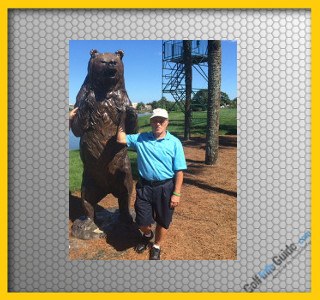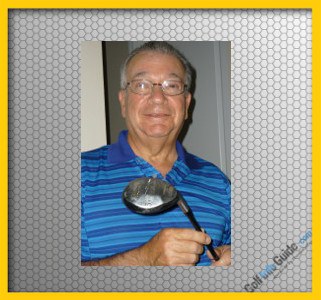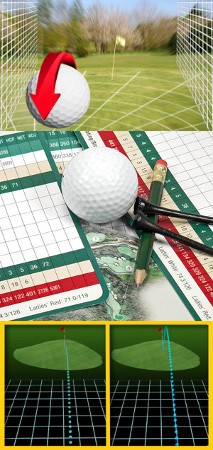Thomas Golf Hole-In-One Club

1. Colin Powers Fairway AT190 – Hole in one at Shamrock Farms
Per a phone discussion last week suggesting that I send you a picture and brief description. I recorded the first hole-in-one in my life last Thursday at Shamrock Farms Par 3 course in Milton, DE, using the 19-wood I had purchased from Thomas Golf last March. It was on hole #10, playing at 108 yards. I am 66, have been playing golf for about 30 years. I am holding the club and ball I used, pictures taken Saturday evening.
Colin Powers

2. Hole in One: Thomas Golf 6 Hybrid
Thank you - I bought the 6 Hybrid liked it and then bought the 5 - got a 7 hybrid from a friend - so I carry 3 Thomas hybrids now - anyway I just got my first hole in one with my 6 - retired 2 yrs ago , play 100 rounds a year now and finally got one - love those clubs - thanks Dave
Thank You,
David Reese
For the second year in a row while on my Winter trip, I have had a Hole IN One using your clubs. Last Winter while in Myrtle Beach I used a 7 Hybrid Iron (AT705) for a hole out at 125 yds. This year while in Arizona, I holed out with a 5 Hybrid Iron (AT705) at 144 yrds. Love the feel and accuracy of your clubs. These were my first and second hole in ones. Thanks
Thank You,
Phil C

4. Hole in one with a Thomas Golf Brand 11 fairway Wood Review
Just dropping you a line to let you know that I had a hole in one at pine brook golf course in Manalapan New. Jersey using a Thomas golf 11 wood. Thanks you
Thank You,
Alan S

5. Hole in One: Thomas Golf AT 705 Number 5 Hybrid Customer Review
I got a hole in one at St. Augustine Golf Club hole # 5 using a hybrid 5 iron made by Thomas golf at a distance of 120 yds. 5 Hybrid, AT705 (27°) (Mens : Right Handed)
Thank You,
Pat N

6. Hole in One: 5 Hybrid, AT705 Left Handed
Good morning ..just to let you know that i bought a hybrid 5 (27 degree) last month. I love it.. and i made my first "hole in one" with the club last Saturday. Distance 180 yards. Thank you Marc
Thank You,
Marc Morin

7. ThomasGolf.com - Customer Care, Michelle Kordopatis
ThomasGolf.com - Customer Care,
I am writing this because my husband and myself use your hybrids. We have both had 2 hole in ones each starting in May and the latest was last night. My husband had both of his in tournaments and has won $25,000 and another for $500. I have not been so lucky I have had to buy drinks! I just want to say thank you for your clubs.Michelle Kordopatis
Thank You,
Michelle Kordopatis

8. Hole in One: Mike Buckman AT 705 Number 8 Hybrid Customer Review
The first hole in one career!
The first round that I used my 8 hybrid AT 705 from Thomas golf I got my first hole in one. The Woods of Westminster in Massachusetts was the course. Par 3 8th hole 145 yards.
Thanks for the hybrid!
Mike

Hole in One Facts and Figures
For the average golfer, a hole in one is perhaps the most exciting single event that can happen on a golf course. While it is also exciting to do something like shoot a new personal low score, or break par for the first time, those achievements take four long hours to complete. On the other hand, a hole in one happens in the blink of an eye. One moment, you are watching the ball flying toward the green, realizing that you have hit a pretty good shot. The next moment, you are jumping up and down after the ball ducks into the hole for an ace. It happens suddenly, and it is a thrill to be sure.
One of the great things about a hole in one is the fact that they can happen to just about anyone who plays this game. The same thing cannot be said of many of the other accomplishments you can shoot for in golf. For example, if you are trying to break par for an entire round, you are going to need to spend years crafting an all-around game. Only experienced, talented players will even have a remote chance of carding an under par round. When it comes to a hold in one, however, all it takes is one good swing. In fact, it doesn't even necessarily require a great swing – you could bounce the ball off a tree and into the hole with the right amount of luck. Nearly anyone can get a hole in one when things come together just right, which is what makes this achievement such a mystical part of the game.
In this article, we are going to take a look at some of the facts and figures related to making a hole in one. Even if these numbers don't make you feel very good about your chances – the odds are long – they are still interesting to consider. It is amazing to think that there are some high-handicap amateurs who have a hole in one to their name, while some accomplished pros can't say the same thing. In addition to discussing statistics, we are also going to provide some hole in one advice for you to use in your own game. While we certainly can't promise that these tips will allow you to make a hole in one, they will improve your chances – at least a little bit.
If you do find yourself experiencing a hole in one in the near future, or you are in a group with another player who knocks one in, be sure to enjoy the moment. Even great golfers never know if or when another hole in one will come along, so feel free to toss your arms up in the air and celebrate. It is possible that another hole in one will come along at some point during your golfing life, but the odds are not in your favor.
All of the content below is written from the perspective of a right-handed golfer. If you happen to play left-handed, please take a moment to reverse the directions as necessary.

Some Basic Numbers
On some level, you don't really need statistics to tell you that a hole in one is a rare accomplishment. Think for a minute about the number of golf shots you have seen in your life, either those you have hit yourself, or those which have been struck by another player in your group. If you have been playing this game for many years, that number is well into the thousands – probably the tens of thousands, if not higher. Then, think about how many holes in one you have actually seen in person. One? Two? Three? No matter what the specific number may be, it is sure to be a low one.
To put some specific numbers to this accomplishment, we will reference some stats provided by the National Hole in One Registry. A few of the most-interesting stats are listed below.
- A hole in one is recorded roughly once every 3,500 rounds. Right off the bat, you can get a pretty good understanding for just how big of a number that is. If you play roughly two rounds of golf per week, all year long, you will play approximately 100 rounds in a year. At that pace, it would take you 35 years before you would reach the average number of rounds for a single hole in one. So, in other words, if you make just one hole in one over an active 35-year golf career, you can consider yourself right in line with the norms. If you make two, you are a serious overachiever!
- The average handicap of an individual making a hole in one is 14. This statistic speaks to the point we made earlier regarding the hole in one being an accomplishment that can happen to anyone. If you analyzed the average handicap of a person breaking par for a whole round, the number would likely be right around 0. However, when it comes to a hole in one, just about any skill level has a chance. As long as you can hit the ball well enough to reach the green on a par three from time to time, you have a shot.
- Only 14% of golfers who make a hole in one will ever make another. Another statistic which demonstrates the unlikelihood of this occurrence in your golf game. This point also speaks to the degree of luck involved with this accomplishment. If it was a matter of skill more than anything else, more than 14% of hole in one makers would find a way to do it again. They don't, which shows how much of this comes down to good fortune and getting the right bounce at the right time.
- The odds of making two in the same round are 67 million to 1. If you think the odds of winning the lottery are stacked against you, just consider the odds of making two hole in ones on the same day – during the same round. This is an incredibly unlikely outcome, and if it does happen to you, the achievement will put you on a very short list with just a few other golfers.
We could go on and on with various statistics that highlight the odds of making a hole in one, but the point is clear – this is a rare achievement, to be sure. The hole in one blends so many of the things that we love about golf into one single package. It requires that you have at least a basic skill set, enough so that you can get the ball up in the air and flying toward the green on a par three. You have to play enough golf to give yourself chances at the hole in one, and playing more is something that is high on every golfer's to-do list. Also, you need to get a bit of luck, which is something that every honest golfer would admit to needing from time to time. When opportunity, skill, and luck all blend together in one magical moment, a hole in one just may be the outcome.

Giving Yourself a Chance
It has already been established that making a hole in one is a major accomplishment, and an unlikely one, at that. There is nothing you can do to make this an easy task, considering that you are going to need plenty of luck to go along with your skill and preparation. However, there are some things you can do to make sure your ball has the best possible chance of going in. If you have been on the hunt for that elusive first hole in one after many years of playing this game, we hope the tips below will help you finally write a '1' down on your card.
- Never up, never in. This is one of the oldest sayings in the book, at least in the world of golf. You will usually hear someone utter this phrase when you leave a putt short on the greens, but it applies just the same when hitting a tee shot on a par three. 'Never up, never in' simply means that you can't make the shot if you don't get it to the hole. Therefore, if you are focused on making a hole in one, you should be sure to use enough club to get the ball all the way to the target. For instance, if you are trying to decide between a seven iron and an eight iron, you may want to go with the seven just to give yourself a better chance of reaching the hole. Club selection alone won't ensure a hole in one, of course, but you can tilt the odds a bit in your favor just by using enough club to reach the target.
- Using slopes to your advantage. Typically, a hole in one is going to take place when the ball is able to roll into the cup. Sure, it could fly directly into the hole without landing on the green first, but that is a rare feat. More often than not, the ball is going to roll in like a putt after landing somewhere else on (or off) the green. So, with that in mind, it makes sense to use the slopes on and around the green to your advantage. If you see that the hole is cut at the bottom of a slope, do your best to place your ball somewhere on that slope while letting it roll down to the location of the hole. Not only is this a good strategy for trying to make a hole in one, but it is simply a good strategy for hitting a successful shot. Play the ball up to the top of a slope where you have some margin for error, and let gravity do the rest of the work. Even if you don't come away with the hole in one you had in mind, you can still wind up with a nice shot and hopefully a makeable birdie putt.
- Spin it back to a front hole location. This is a tip which is only going to work when playing a short par three – something less than 150-yards or so. When on a short par three, and when the hole is cut near the front of the green, you may be able to secure that elusive hole in one by spinning the ball back into the cup. A well-struck wedge shot should be able to provide you with a high backspin rate, maybe even high enough to cause the ball to spin back toward the front of the green after it lands. This is a great way to get a hole in one because the ball will be rolling at a comfortable pace, giving it a chance to grab the flag stick and fall in. To get your ball to actually spin back, you are going to need to hit down sharply at impact, and you will also need to use the right kind of golf ball (something with a relatively soft cover).
- Play with no fear. If your primary goal for a round of golf is to shoot the lowest possible score, you really aren't going to be aiming at all of the hole locations on the par threes. When the hole is cut near a bunker or water hazard, for example, you will aim away from the cup and play to a safer part of the green. However, if your primary goal is to give yourself a chance for a hole in one, you can't afford to play so safe. Instead, you will need to take aim at the hole itself on each swing. This plan is sure to backfire in some instances, but it will serve you very well at other times. Think about what you want to get out of your round and decide from there how to proceed.
We aren't pretending that you are going to immediately head out and make a hole in one just because you read these tips. Making a hole in one is extremely difficult, and that isn't going to change unless you find a golf course with greens designed in the shape of a funnel. However, you can give yourself a chance to make a hole in one at some point in the future by keeping some of these tips in mind. If the perfect combination of execution and good fortune happens to come your way, one of these shots might actually find its way to the bottom of the cup for a thrilling ace.

Aces at the Top of the Game
As you would expect, holes in one happen on the PGA Tour with a much higher frequency than they happen in the amateur game. That is an obvious point, as professional golfers are much more accurate and consistent than their amateur counterparts. Pro golfers aren't perfect, but they do hit the ball at the target with regularity – and at least a few of those shots are bound to fall in over the course of a long PGA Tour season.
So what do the stats look like with regard to aces on the PGA Tour? Let's take a look at a few interesting numbers.
- The career record is 10! Right off the bat, we start with an incredible statistic. Despite the long odds for any golfer when it comes to making a hole in one, two players in PGA Tour history have recorded ten aces in PGA Tour competition alone. Both Hal Sutton and Robert Allenby have 10 Tour aces to their credit, and it is likely that they have made many more on their own time. Most golfers would love to make just one ace in a lifetime, so it is amazing to think that these two professionals have made 10 while playing difficult Tour-level golf courses. In all, there are 16 players who have made at least six aces in PGA Tour history.
- A full-field event means a good chance of an ace. According to the US Hole in One Association, a full-field PGA Tour event offers a 1 in 4.5 chance of a hole in one taking place on any given day (before the cut has been made). When you think about it, those are impressively optimistic odds considering the difficulty of the task at hand. If you have a chance to attend a PGA Tour event in person, consider setting up near the green of a short par three to watch the action – you just might see an ace!
- Roughly five times more likely than an amateur player. Golf Digest pegs the odds of a professional golfer making a hole in one at 2,500 to 1. That might seem like a lock shot, but it is far more likely to occur than an amateur hole in one, which they peg at 12,500 to 1 (across all amateurs of varying skill levels).
It is no surprise that you are more likely to see a hole in one when watching professional golf on TV than you are to see one in your own group. The pros are incredibly good at this game, and they send the ball up near the hole with impressive consistency. Even on difficult golf courses with plenty of pressure, a few of those great shots are bound to fall in from time to time.

Moving On
So, for the purposes of this final section of the article, let's imagine that you do manage to knock one in the hole for an ace. To be sure, you will spend a couple moments jumping around, throwing your hands in the air, and celebrating with your friends. When that is over, however, it will be time to retrieve the ball and move on with your round. But how do you do so successfully after such an exciting event? The tips listed below will aim to help with just such a 'problem'.
- Put the ball away. The first thing you should do is tuck the hole in one ball into a safe spot in your bag while putting out a new ball to continue on with the round. You are going to want to keep the hole in one ball as a souvenir, and you don't want to have to worry about hitting it into a water hazard while finishing out the rest of the holes. When the round is done, you may want to write a few pieces of key information on the ball, such as the date, the yardage, and the club you used.
- Don't waste this opportunity. Not only is a hole in one an exciting accomplishment all on its own, it is also a great chance to shoot a low score. After all, making a hole in one means you have played that par three in two under – giving you a chance to do something special with your round. No matter what your own personal best score is, any round which includes a hole in one will offer an opportunity to better that record.
- Slow yourself down. Your adrenaline is sure to be flowing after making a hole in one, which means your tempo will likely be out of control on the next tee. Before you hit your tee shot on the next hole, take a moment to collect yourself and focus on the task at hand. There will be plenty of time later to celebrate and relive the moment – for now, get back into your regular tempo and do your best to play good golf the rest of the way out.
Holes in one are one of the magical parts of golf. Since they can happen to nearly anyone, they bring together golfers in a way that nothing else can. A high-handicap player might not be able to relate to a professional who shoots in the 60s on a regular basis, but those two players could bond over the shared experience of an ace. Here's hoping you can celebrate one of your own in the near future!






